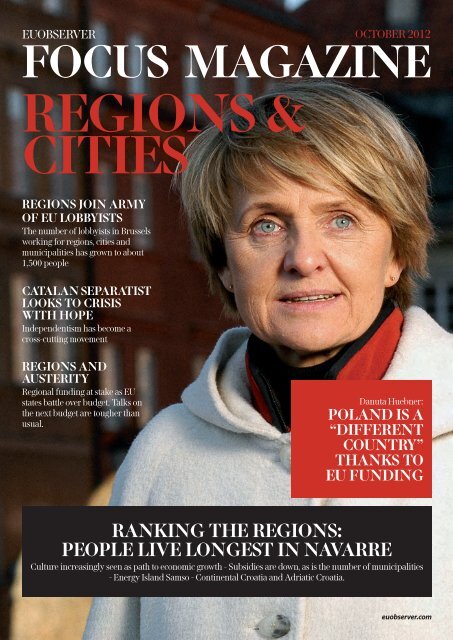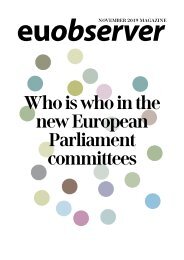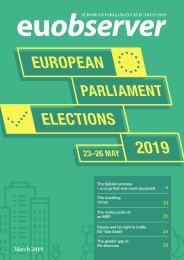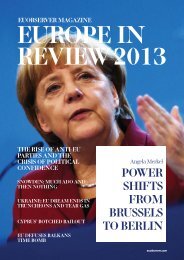Regions & Cities 2012: Economic Crisis & Austerity
The 2012 edition of EUobserver's Regions & Cities magazine looks at the impact of the economic crisis on Europe.
The 2012 edition of EUobserver's Regions & Cities magazine looks at the impact of the economic crisis on Europe.
You also want an ePaper? Increase the reach of your titles
YUMPU automatically turns print PDFs into web optimized ePapers that Google loves.
EUOBSERVER<br />
OCTOBER <strong>2012</strong><br />
FOCUS MAGAZINE<br />
REGIONS &<br />
CITIES<br />
REGIONS jOIN ARMy<br />
OF EU lobbyISts<br />
The number of lobbyists in Brussels<br />
working for regions, cities and<br />
municipalities has grown to about<br />
1,500 people<br />
CatalAN SEpARAtISt<br />
lOOks to CRISIS<br />
with hope<br />
Independentism has become a<br />
cross-cutting movement<br />
REGIONS AND<br />
AUSTERIty<br />
Regional funding at stake as EU<br />
states battle over budget. Talks on<br />
the next budget are tougher than<br />
usual.<br />
Danuta Huebner:<br />
PolAND IS a<br />
“DIFFERENt<br />
COUNtry”<br />
thANks to<br />
EU FUNDING<br />
RANkING the REGIONS:<br />
pEOple live lONGESt IN NavARRE<br />
Culture increasingly seen as path to economic growth - Subsidies are down, as is the number of municipalities<br />
- Energy Island Samso - Continental Croatia and Adriatic Croatia.<br />
euobserver.com<br />
OCTOBER <strong>2012</strong> REGIONS & CITIES 1
EUOBSERVER MAGAZINE<br />
REGIONS & CITIES<br />
OCTOBER <strong>2012</strong><br />
For one week every year European regions are in the spotlight. It’s<br />
called Open Days, lasts a week, and is dedicated to all issues regional<br />
and local.<br />
From every corner of the continent, thousands of local leaders and<br />
administrators come to Brussels to talk directly to EU officials and<br />
lawmakers. It is a time of networking, exchanging ideas and passing<br />
on information.<br />
Lest we forget, it is also about celebrating the best of what Europe<br />
can produce! A vast array of local products – foods, wines, regional<br />
specialities – will fill the Belgian capital from 8 -11 October.<br />
But this year’s regional get-together will be more political than usual.<br />
The same economic crisis that has led to austerity in local governance<br />
is also directly affecting the EU’s negotiations on its next longterm<br />
budget. Meanwhile, regional calls for more influence or even<br />
outright independence are getting stronger.<br />
It is against this complex backdrop that EUobserver Magazine takes<br />
Europe’s regional temperature. Other news and analysis on regions<br />
and cities can be found on EUobserver.com.<br />
EDITORIAL ADDRESS<br />
EUobserver Magazine<br />
Rue Belliard 203, bté 5<br />
1040 Bruxelles<br />
Belgium<br />
contact@euobs.com<br />
Editor: Lisbeth Kirk<br />
Editorial contributors: Honor Mahony & Philip Ebels<br />
Design: Tobias Andreasen<br />
Cover photo: © European Union, <strong>2012</strong><br />
ADVERTISING<br />
EUobserver Magazine<br />
Rue Montoyer 18B<br />
1000 Brussels<br />
Belgium<br />
Filip Lugovic<br />
fl@euobs.com<br />
PRINT<br />
PMR<br />
DISTRIBUTION<br />
EUobserver Magazine<br />
Rue Montoyer 18B<br />
1000 Brussels<br />
Belgium<br />
Meg Chang<br />
mc@euobs.com<br />
Price per copy<br />
€4,75 + postage, excl vat / discounts on larger purchases<br />
Publisher<br />
EUobserver.com ASBL<br />
www.euobserver.com<br />
EUobserver is an English language online newspaper covering European<br />
Union affairs. It is constituted as a non-profit organisation under Belgian law<br />
raising revenue on a commercial basis through a variety of income streams<br />
including advertising, fundraising, conferences, magazines and book sales.<br />
BERLIN / KEY FACTS<br />
Population 3.501.872, about 6 million in<br />
the Capital region Berlin-Brandenburg<br />
Joint Innovation Strategy of the Capital Region of<br />
Berlin and Brandenburg (innoBB)<br />
The “Joint Innovation Strategy of the States of Berlin<br />
and Brandenburg (innoBB)” was adopted by the Berlin<br />
Senate and the Brandenburg Cabinet on 21 June<br />
2011.<br />
The following cross-border clusters are an important<br />
employment factor for the region:<br />
• Life Sciences & Healthcare<br />
350.000 employees<br />
• Energy, Transport and Logistics<br />
47.000 employees<br />
• ICT, Media, Creative Industries<br />
158.000 employees<br />
• Photonics (including Microsystems Technology)<br />
16.000 employees<br />
Scientific Landscape of the Capital Region:<br />
• 7 Universities<br />
• 21 Universities of Applied Science<br />
• 70 Research Institutes<br />
• 42 Technology Centres<br />
Read more at www.innobb.de<br />
2 OCTOBER <strong>2012</strong> REGIONS & CITIES
REGIONS FEEl<br />
the pINCh<br />
Central governments are hoping to cut costs even further by reducing the number of municipalities<br />
and telling them to cooperate more.<br />
By: Philip Ebels<br />
L<br />
ooking to save a buck in every<br />
corner of the budget, EU countries<br />
are now pointing their arrows at<br />
subnational governments, a new<br />
study has found.<br />
The study, carried out by Dexia Credit<br />
Local and presented in September this<br />
year, shows that after two years of pumping<br />
money into regions, central governments<br />
are now tightening their belts.<br />
In 2011, the amount of grants and subsidies<br />
to federated states, regions, provinces, and<br />
municipalities fell by 4.9 percent, according<br />
to the study, following a 0.6 percent drop in<br />
2010.<br />
Grants and subsidies account for almost half<br />
the total income of subnational governments.<br />
Other sources of income include local taxes<br />
and user charges - the fees people pay to<br />
make use of services like parking and public<br />
transport.<br />
As a result, subnational governments, too,<br />
are cutting down on spending.<br />
In 2011, the study says, local direct<br />
investment fell by 6.6 percent, following a 7<br />
percent drop in 2010. Today’s level is back at<br />
where it was in 2006.<br />
Public direct investment is money that goes<br />
into things like schools, hospitals or waste<br />
management, two thirds of which comes<br />
from subnational governments, according to<br />
the study, commissioned by the Council of<br />
European Municipalities and <strong>Regions</strong>.<br />
“The subnational public sector [is] an engine<br />
for public investment,” it says. In bigger<br />
countries like France, Germany or Italy, it<br />
accounts for almost three quarters of public<br />
direct investment.<br />
The two-year drop is a first after a decade of<br />
“robust” growth, the study says.<br />
Subnational governments have only been<br />
able to balance the books by cutting down on<br />
staff costs - the first time in a decade - and<br />
because in some countries, the economy<br />
has begun to pick up. Local tax revenues<br />
rose by 5.5 percent, after a slump in recent<br />
years.<br />
“It is a stability in disguise,” said Isabelle<br />
Chatrie, author of the study.<br />
Meanwhile, central governments are hoping<br />
to cut costs even further by reducing the<br />
number of municipalities and telling them to<br />
cooperate more. It is a trend of the past few<br />
decades but gained in speed over the last<br />
couple of years.<br />
“Municipal mergers have picked up with the<br />
crisis and austerity plans,” she says.<br />
In Greece and Portugal, who both agreed to<br />
reforms in return of a bail-out, reducing the<br />
number of subnational governments is even<br />
part of the deal with the so-called troika of<br />
international lenders - the International<br />
Monetary Fund, the European Central Bank,<br />
and the European Commission.<br />
Greece, who in 1997 had already gone from<br />
5,825 to 1,034 municipalities, went to 325 in<br />
2010. Portugal boasted 278 municipalities in<br />
2011. In May of the same year it agreed to<br />
reduce “the number of municipal offices by<br />
at least 20% per year in <strong>2012</strong> and 2013.”<br />
Overall, the number of municipalities in<br />
the EU, according to Dexia, dropped from<br />
92,735 in 2004 to 89,149 in 2011.<br />
For their part, subnational governments<br />
themselves are not celebrating the relative<br />
decline of their own species.<br />
“The troika thinks that budget control is<br />
better on the central level, but they are<br />
wrong,” Frédéric Vallier, secretary general of<br />
the Council of European Municipalities and<br />
<strong>Regions</strong>, told EUobserver.<br />
“For us, it is about responsibility. Everything<br />
that gives us more responsibility is good,” he<br />
added.<br />
OCTOBER <strong>2012</strong> REGIONS & CITIES 3
CatalAN SEpARAtISt lOOks to<br />
CRISIS with hope<br />
It is often said that on the long and winding road to European union, it takes a crisis to move ahead.<br />
Now the same may be true for regional independence.<br />
By: Philip Ebels<br />
E<br />
Europe has always had its share<br />
of movements calling for the<br />
breakaway of an often distinct part<br />
of a larger country. Most well-known<br />
are Scotland in the UK, Flanders<br />
in Belgium, and Catalonia and the<br />
Basque Country in Spain.<br />
But the dire state of much of the continent’s<br />
public finances, they say, is giving them a<br />
larger audience willing to listen.<br />
Jordi Sole, secretary general of the European<br />
Free Alliance, a group in the European<br />
Parliament of parties for more regional<br />
autonomy, told EUobserver that people have<br />
come to see two things.<br />
“One: You cannot lose because the situation<br />
is already quite desparate. And two: They see<br />
independence as a tool to have hopes for the<br />
future,” he said.<br />
He noted that previously, people may<br />
have been afraid of the consequences of<br />
a unilateral break-up. Until recently, full<br />
independence was a radical thought.<br />
“But now, independentism has become a<br />
cross-cutting movement, from the left to the<br />
right, young and old,” he added.<br />
Sole, who is also the mayor of a small town<br />
called Caldes de Montbui, 30km north of<br />
Barcelona, was mainly talking about Spain.<br />
On 11 September, Catalonia’s national<br />
holiday, hundreds of thousands of people<br />
took to the streets of the region’s capital in<br />
what became the biggest independence rally<br />
in recent history.<br />
Spain has been hit particularly hard and is<br />
telling its regions to cut down on spending.<br />
Catalonia, the country’s richest region, feels<br />
it is paying too much already and getting<br />
too little in return - even though it, too, has<br />
overspent and received an €11 billion loan<br />
from the central government in Madrid.<br />
But also elsewhere in Europe, Sole said,<br />
people are looking to regional independence<br />
as a way out of the crisis. Most notable is<br />
Scotland, which in 2014 is planning to hold a<br />
referendum on the issue - even though, being<br />
outside the common currency, it has suffered<br />
less.<br />
“I am convinced that the eurocrisis is having<br />
an impact on the self-determination of several<br />
stateless nations in Europe,” he said.<br />
He said the crisis is making people poor,<br />
and when people are poor “they are seeking<br />
solutions.”<br />
Those most vocal about independence<br />
however - Catalonia, Flanders, Scotland - are<br />
not poor when compared to other parts of the<br />
country to which they belong.<br />
It is an uncomfortable reality that opponents<br />
thankfully make use of to denounce the<br />
movement as selfish.<br />
Sole does not agree. Instead, he says, being<br />
relatively rich merely allows a region to stand<br />
up for itself.<br />
“The more rich, the more a society can<br />
express more easily the desire to belong to<br />
[its own] political nation,” he said.<br />
In Catalonia, meanwhile, things are moving<br />
fast. Days after the protest in Barcelona, the<br />
region’s president Artur Mas and Spain’s<br />
prime minister Mariano Rajoy failed to reach<br />
an agreement on fiscal reform asked for<br />
by the Catalan parliament, sparking the<br />
region’s president to call for early elections in<br />
November.<br />
Polls show a slim majority of voters in favour<br />
of independence, twice as high as when the<br />
crisis began in 2008. Sole’s party Esquerra, or<br />
the Republican Left of Catalonia, the loudest<br />
voice for full independence, is expected to<br />
jump from fifth to third biggest in the region.<br />
“Things have advanced more in the last 10<br />
days than they have in the last 10 years,” Sole<br />
said.<br />
“We could be on the eve of a new state<br />
forming. And this could have a domino effect<br />
in the EU,” he added.<br />
4 OCTOBER <strong>2012</strong> REGIONS & CITIES
SuStainable CitieS<br />
Master of Science Programme<br />
C O P E N H AG E N<br />
Nordic countries are at the forefront regarding “Sustainable <strong>Cities</strong>” planning, such as:<br />
• Renewable Energy Production and Energy Efficient Buildings<br />
• Green Mobility and a Green Urban Environment<br />
• Resource and water systems as well as Transition Processes for Sustainable Development<br />
As a student at the Sustainable <strong>Cities</strong> MSc programme you will:<br />
• Work with real-life problems and solutions in a cross-disciplinary setting combining engineering and social science<br />
• Work in groups on projects and be afforded the opportunity to carry out an internship in e.g. a company or planning authority<br />
Location from September <strong>2012</strong>:<br />
Aalborg University<br />
A.C. Meyers Vænge 15<br />
DK-2450 Copenhagen SV<br />
Contact:<br />
Allis Hansen<br />
Phone: +45 9940 7216<br />
E-mail: allis@plan.aau.dk<br />
Teamwork<br />
Related MSc programmes:<br />
· Energy Planning and Management - http://www.energyplanning.aau.dk/<br />
· Environmental Management and Sustainability Science - http://www.environmentalmanagement.aau.dk/<br />
· Urban Planning and Management - http://www.urban.aau.dk/<br />
www.sustainablecities.aau.dk<br />
www.studyguide.aau.dk<br />
OCTOBER <strong>2012</strong> REGIONS & CITIES 5
MIFFED CROAtIAN REGION FEARS<br />
UNEqUAl ACCESS to EU MONEy<br />
The EU has a large pot of money especially for regions. How to get hold of this money is a source of<br />
much negotiation in member states - as a poor region in upcoming EU member Croatia has found out.<br />
By: Honor Mahony<br />
in terms of wealth there is little<br />
to distinguish the Croatian city<br />
from other EU capitals<br />
FOR ENGLISH SPEAKERS<br />
it is a somewhat unfortunate<br />
acronym covering a dullsounding<br />
issue. But for member<br />
states, Nuts - the EU system for<br />
statistically dividing up regions -<br />
is the key to access deep pots<br />
of money.<br />
<strong>Regions</strong> qualify for EU aid money<br />
if their per capita GDP is under 75<br />
percent of the EU average. There<br />
are currently 270 “basic regions”<br />
in the EU. When Croatia joins<br />
next year there will be two more<br />
- Continental Croatia and Adriatic<br />
Croatia.<br />
But the country’s poorest region<br />
is up in arms over the artificial<br />
partition.<br />
Slavonia, previously a welloff<br />
agricultural region but now<br />
with GDP at 34 percent of the<br />
EU average, has been lumped<br />
together with Zagreb. In wealth<br />
terms there is little to distinguish<br />
the Croatian capital from other<br />
major European cities. The result<br />
is that the average wealth of<br />
Continental Croatia is now 64.1<br />
percent.<br />
6 OCTOBER <strong>2012</strong> REGIONS & CITIES<br />
“When I go to Brussels to talk<br />
about my region. The first they<br />
ask is: what is your GDP? We got<br />
30 percent extra GDP overnight.<br />
But it doesn’t reflect reality,”<br />
says Stjepan Ribic, director of<br />
the Slavonia & Baranja regional<br />
development agency.<br />
Stjepan Ribic<br />
“We woke up at the end of the<br />
August,” says Ribic, to see it<br />
divided into two regions.<br />
The government, which had<br />
previously mooted plans to divide<br />
Croatia into five separate regions<br />
including one for the capital - has<br />
been saying the EU commission<br />
would not allow Zagreb region<br />
status. The commission says it<br />
was never asked.<br />
Ribic, who hails from the<br />
regional centre-right HDSSB<br />
party, fears Slavonia will not be<br />
able to compete with Zagreb. It<br />
does not have the money to hire<br />
consultancies to make glossy<br />
presentations to EU officials.<br />
“Good ideas are not enough.<br />
The EU does not pay for ideas.<br />
It pays for good, safe-looking<br />
projects,” he said. Both Slavonia<br />
and Zagreb will battle to host,<br />
amongst other things, a new<br />
university campus and a waste<br />
treatment plant.<br />
Agreeing broad priorities for<br />
EU money - often a problem<br />
for regions - becomes an even<br />
greater issue when the region<br />
itself is so disparate.<br />
Photo: Mario Fajt<br />
“I would say the clearance of<br />
landmines is our priority number<br />
one,” said Ribic, with 500 people<br />
having died because of them<br />
since the end of the 1991-1995<br />
war with Serbia. Often lying just<br />
off the road, the mines’ presence<br />
is not only a danger to locals but<br />
hinders investment and tourism.<br />
“But that’s hardly going to be the<br />
priority of Zagreb,” Ridic added.<br />
“You cannot believe how<br />
important Nuts 2 is for regions.<br />
It is everything,” he noted. He<br />
advised regions of potential<br />
future member states to “keep<br />
their eyes open.”<br />
NUTS<br />
Nuts stands for ‘Nomenclature of territorial units for statistics’. Drawn up over<br />
30 years ago, it is the system used for dividing up European Union territory<br />
for statistical purposes. It is on this basis that economic and social analyses<br />
are carried out and EU aid money is allocated. There are three categories.<br />
Nuts 1 are major-socio economic regions. There are 97 in the EU<br />
Nuts 2 are basic regions. It is on the basis of these that EU regional funds<br />
are allocated. There are 270 of them<br />
Nuts 3 are small regions. There are 1,294 of them<br />
Belgium, for example, has three regions at Nuts 1 level; 11 provinces at Nuts<br />
2 level and 44 arrondissements at Nuts 3 level.
Donetsk Governor<br />
Andrey Shishatskiy<br />
Donetsk has always had close ties with<br />
European investors ever since the city of<br />
Donetsk was first founded by the Welsh<br />
entrepreneur John Hughes in 1869.<br />
This summer more than 300,000<br />
visitors came to Donetsk and experienced<br />
the warmth and hospitality of our people.<br />
The citizens of Donetsk were the City’s<br />
best ambassadors as they looked after<br />
the fans coming for UEFA EURO <strong>2012</strong>.<br />
It is the human capital of Donetsk that<br />
gives the region our greatest strategic<br />
advantage in attracting new investment<br />
and business partners.<br />
A top priority for Donetsk regional<br />
authorities is to extend a warm welcome<br />
for investors to ensure that their business<br />
is valued here.<br />
We are modernising and upgrading<br />
our traditional industries, we are<br />
also taking steps to diversify and<br />
internationalise our economy into new<br />
technology and service sectors.<br />
There are opportunities in energy,<br />
machine tools, software development,<br />
tourism, agriculture and services.<br />
Donetsk is open for business and we<br />
aim to help investors succeed.<br />
Ten good reasons to invest in Donetsk:<br />
> Highly skilled and productive labour force, with scientific and technical resources<br />
for research and development.<br />
> Favourable geographical position – gateway to Eastern Europe.<br />
> The leading industrial production centre of Ukraine and Eastern Europe’s exhibition<br />
market leader.<br />
> Well-developed infrastructure.<br />
> Rich in natural resources and raw materials for agriculture and industry.<br />
> Strong financial and banking services.<br />
> Reasonable real estate prices and energy prices.<br />
> Extensive international links.<br />
> Diverse investment opportunities and investment experience.<br />
> Beneficial conditions for the development of tourism and leisure opportunities.<br />
Donetsk Region Key Facts:<br />
The Donbass Arena – Key venue for UEFA EURO <strong>2012</strong><br />
Population: 4.7 million<br />
Area: 26 900 km2 (4.4% of Ukraine)<br />
Capital: Donetsk<br />
Main Sea Port: Mariupol<br />
Main Airport: Donetsk, Sergey Prokofiev International Airport<br />
Key industries: Coal, steel, Iron (50% of all Ukrainian production), Agriculture<br />
GDP per capita: 30% higher than the Ukrainian average<br />
Productivity: Accounts for 20% of all Ukrainian exports
REGIONAl<br />
FUNDING<br />
at stake AS<br />
EU statES<br />
battle ovER<br />
bUDGEt<br />
The eurozone crisis is testing the EU’s capacity for solidarity. This is<br />
spilling over into the budget talks where different ideological camps<br />
are battling. At stake is the future size and shape of regional funding.<br />
By: Honor Mahony<br />
E<br />
U budget negotiations are famous<br />
for bringing out the worst of what’sin-it-for-me<br />
politics.<br />
Every seven years, the EU’s coffers need to<br />
be refilled. All governments contribute. The<br />
cash is then redistributed among member<br />
states who fight tooth and nail to get their<br />
due.<br />
So far, so very EU long-term budget. But the<br />
current economic crisis means talks on the<br />
next budget (2014-2020) are tougher than<br />
usual.<br />
There is less money to go around and richer<br />
states are feeling the pinch.<br />
“This is going to be an extremely important<br />
budget because Europe desperately needs<br />
growth and jobs,” says Danuta Huebner,<br />
head of the parliament’s regional affairs<br />
committee.<br />
“In the current reality, when the national<br />
budgets will continue to suffer cuts, it is the<br />
EU budget that can really be the catalyzer<br />
for investment and growth,” she adds.<br />
But it is just in the policy that is meant to<br />
boost growth – Cohesion Policy – where the<br />
hardest battle is being fought.<br />
The European Commission last year<br />
suggested a total seven-year EU budget<br />
of €1.025 trillion, €336bn was to be for<br />
Cohesion Policy.<br />
The policy, which includes the European<br />
Development Fund, the European Social<br />
Fund and the Cohesion Fund, took a hit of<br />
€18 billion compared to the current 2007-<br />
2013 budget. A further €5.5 billion was<br />
€5.5 billion was<br />
chopped this year<br />
when the commission<br />
updated its proposal.<br />
chopped this year. And bickering among<br />
member states means a third cut is likely.<br />
This is short-sighted, believes Huebner.<br />
“This is really the investment policy and the<br />
growth policy,” she notes.<br />
“One of the values of regional policy is that<br />
it takes into the specificities of European<br />
territory. We have places in Europe where<br />
to become competitive and to grow you still<br />
need the basic investment in infrastructure.<br />
“No investor would go to a city or a region<br />
that has no connection with the rest of<br />
Europe. There is still a huge part of Europe<br />
that require investment infrastructure.”<br />
At the budget negotiation level, member<br />
states are divided into two broad camps.<br />
The first camp – including Germany, Finland<br />
and the Netherlands – say their own citizens<br />
are feeling the effects of budget cuts and a<br />
large EU budget is not justifiable.<br />
The second – broadly poorer eastern<br />
European states – say that argument does<br />
not take into account the leverage effect<br />
of EU aid money and that the cuts already<br />
made are enough. The two sides are about<br />
€100 billion apart.<br />
“It is the first group for sure that have the<br />
better argument,” said Marco Lopriore,<br />
a regional policy expert at the European<br />
Institute of Public Administration<br />
“We are in a time of economic recession.<br />
We need to bring results to the European<br />
parliament and European citizens.”<br />
The backdrop to the rich states’ argument is<br />
not only the austerity cuts sweeping Europe<br />
but also poor past records of spending EU<br />
money. Millions of euros flowed to Greece,<br />
Italy and Spain over past decades with little<br />
of use to show for them.<br />
8 OCTOBER <strong>2012</strong> REGIONS & CITIES
Meanwhile, academics note that the entire debate is based on<br />
fuzzy grounds.<br />
“The problem regarding cohesion policy is that there are very<br />
few instruments to measure the impact of the investment,” said<br />
Claire Dheret of the European Policy Centre, a Brussels-based<br />
thinktank.<br />
The European Commission has conducted “a lot of studies on the<br />
achievements of cohesion policy but there are many economists<br />
who don’t agree with the model used to assess its impact.”<br />
But, says Huebner, it is all too easy just to criticise.<br />
Referring to her native Poland, an EU member since 2004, she<br />
said: “It is a different country now. That’s all thanks to European<br />
contributions, the transfer of funds.”<br />
“I often hear criticism - well there was a pizzeria financed in one<br />
of the regions - but this pizzeria is a small enterprise which gives<br />
jobs, creating the first ever restaurant in the village. This gives a<br />
lot of value.”<br />
And the parliament may turn out to be the regions’ ally in the<br />
budget negotiations.<br />
Last year MEPs suggested a five percent increase for 2014-2020<br />
budget.<br />
Danuta Huebner - Poland is a “different country” thanks to EU funding<br />
“There is a risk that if the budget is below the expectations of<br />
the European Parliament, then we will veto it,” says the Polish<br />
deputy.<br />
Photo: EPP Group<br />
Faced with the crisis: The <strong>Regions</strong> at Europe's bedside<br />
T h e Pe s c a r a S u m m i t<br />
allowed for an in-depth<br />
exchange of views in four<br />
key fields: education and<br />
training, eco-innovation,<br />
s m a l l a n d m e d i u m<br />
enterprises, demographic<br />
change and culture. Access<br />
the resolution made at<br />
Pescara to discover the<br />
main recommendations:<br />
www.aer.eu<br />
The Assembly of European <strong>Regions</strong> (AER) has<br />
launched a large reflexion on the potential of<br />
the regional level in times of crisis. Around<br />
100 politicians from the regions of Europe,<br />
national and European representatives,<br />
stakeholders from the private sector and<br />
associations heard this appeal and gathered<br />
last September in Pescara, in the Abruzzo<br />
Region (I), for an in-depth exchange of views.<br />
The so-called Abruzzo appeal marked the kickoff of a process that will continue until<br />
2013 through two other summits, focused respectively on the exchange of regional<br />
successful experiences, and the implementation and outcome of the decisions<br />
made. Michèle SABBAN, AER President, invites each person willing to contribute to<br />
cure Europe to join the movement: next steps foreseen in February 2013 in Warsaw<br />
(PL) for the second act, and in May 2013 in Paris (F) for the 3 rd Summit.<br />
The Assembly of European <strong>Regions</strong> (AER)<br />
is the largest independent network of<br />
regions in wider Europe. Bringing<br />
together more than 250 regions from<br />
35 countries and 16 interregional<br />
organisations, AER is the political voice of<br />
its members and a forum for interregional<br />
co-operation.<br />
The current negotiations on the next Multi-annual Financial Framework and EU<br />
structural funds are crucial for the future of Europe: only strong<br />
and targeted EU-wide policies, based on a genuine<br />
partnership that fully includes the regional level, can have the<br />
necessary leverage effect that will allow Europe to exit from the<br />
economic downturn. In this respect, AER warns of a macroeconomic<br />
conditionality that would hamper this leverage effect<br />
and impact negatively on sustainable growth and jobs.<br />
OCTOBER <strong>2012</strong> REGIONS & CITIES 9
SAMSO<br />
– DENMARk’s pIONEERING<br />
ISlAND<br />
Samso is a pioneering Danish island - it became energy independent in 2008, but people are not in it<br />
“for the environment.”<br />
By: Honor Mahony<br />
In 1997 SAMSO IslAND wON a<br />
COMpetitION.<br />
The prize? Showcasing Denmark’s capacity<br />
for renewable energy.<br />
It was a low key affair. Winning entailed<br />
a meeting with the then energy minister.<br />
Neither extra resources, technology or<br />
money were part of the prize.<br />
Just over 10 years later the island - tucked<br />
away in the Kattegat Strait in the Baltic<br />
Sea - has become 100 percent energy<br />
independent.<br />
Wind turbines provide all its electricity.<br />
Seventy percent of islanders heat their<br />
homes and their water using centralised<br />
systems run on wood or straw. The 4,300<br />
residents – known as “Samsingers” – are<br />
carbon neutral. Or, to be exact, their carbon<br />
footprint is minus 3.7 tonnes.<br />
There are plans for the island to be entirely<br />
fossil-fuel-free by the end of this decade.<br />
Vehicles – including trucks and tractors –<br />
are to run on methane gas. An electric bus<br />
system should be in place within the next<br />
year.<br />
So how was it possible to get from energyimporting<br />
A to energy-independent B?<br />
What it did not involve was mass popular<br />
conversion to all things green. In fact, being<br />
evangelical about sustainable energy was<br />
likely to be viewed with suspicion. What<br />
won Samsingers round was the twin forces<br />
of enlightened self-interest and a singularly<br />
persuasive local.<br />
That local was Soren Hermansen.<br />
Son of island farmers, Hermansen first<br />
trained as a farmer and then worked as<br />
an environmental studies teacher. He saw<br />
the potential of the small windy island from<br />
the beginning. He provided the opening to<br />
locals. An engineer was able to answer the<br />
technical questions.<br />
The hard task was to win around conservative<br />
islanders. It involved going to many local<br />
meetings. The message was tailored to the<br />
fisherman audience in the southwest, to the<br />
farmers in the south and the independentminded<br />
locals of the northern community.<br />
That the island is only 114km square with 22<br />
villages was of no matter.<br />
“So we were two guys working on it ...<br />
Samso is not one community – it is several<br />
communities. We took one area at a time,”<br />
Hermansen said.<br />
The worries were practical. People wanted<br />
to know: “What’s in it for them. Whether they<br />
can save money on their bills.”<br />
Some signed up to the idea immediately.<br />
Others were sceptical. But the majority was<br />
eventually convinced.<br />
By 2001,the island had cut its fossil fuel use<br />
by half, four years later it was producing more<br />
renewable energy than it needed. There are<br />
now 11 on-shore wind turbines providing the<br />
island’s electricity. Ten off-shore turbines offset<br />
the island’s transportation needs - the<br />
three ferries serving Samso guzzle oil.<br />
Soren Hermansen - “Why big politics often gets<br />
stuck is because people want to do everything”<br />
Over €60 million has been spent since<br />
the project began, 70 percent of which<br />
was private investment by islanders. The<br />
dividends come in the form of lower fuel bills<br />
and cheques for those who took out shares<br />
in the turbines.<br />
An foreseen but welcome spin-off are the<br />
6,000 visitors coming each year to admire<br />
and learn about the island’s evolution to<br />
energy self-sufficiency.<br />
Hermansen credits the islanders for the<br />
success of the project. But it was also down<br />
to keeping the aim of the project realistic and<br />
in touch with what local people wanted.<br />
“You have to look at each area and see ...<br />
what are the strengths of the different areas.<br />
Why big politics often gets stuck is because<br />
people want to do everything - it gets too big<br />
and then people cannot absorb it.<br />
“Better to go down to a lower level and focus<br />
on local and regional development.”<br />
A view of the island - Samso became energy independent in 2008<br />
Photo: Jeppe Jensen<br />
10 OCTOBER <strong>2012</strong> REGIONS & CITIES
SILESIA’S GENES<br />
FOR SUCCESS<br />
For the seventh time<br />
in a row Silesia (Śląskie)<br />
has been ranked as<br />
the most attractive<br />
investment location<br />
in Poland. The Katowice<br />
Special <strong>Economic</strong> Zone<br />
has created tens<br />
of thousands of new<br />
jobs in 35 cities<br />
of the province.<br />
The region inhabited by 4.6 million<br />
people, has the highest population<br />
density in Poland and is the most<br />
urbanized area in Central Europe.<br />
Traditional work ethos is a good<br />
mark of the people who have<br />
worked here in industry for<br />
generations. Silesia has a workingage<br />
population of over 3 million.<br />
The province’s active business<br />
networks and dynamic market<br />
are the product of true team<br />
work. The 45 universities and<br />
colleges of Śląskie province tutor<br />
almost 200,000 students, with<br />
60% of them studying for degrees<br />
in engineering and economics.<br />
Silesia is one of Poland’s leading<br />
centres for R&D. The first artificial<br />
heart or design initiatives are<br />
the showpieces of our creative<br />
potential. An innovative approach<br />
to business contributes to success<br />
of the firms, which operate<br />
in the province.<br />
There are 18 industry and<br />
technology parks operating<br />
in the energy, automation,<br />
electronics and construction<br />
sectors. Over 2 million creative<br />
people living in 14 cities<br />
of the so-called Silesia Metropolis<br />
create the region’s positive energy.<br />
Silesia’s densest network of<br />
expressways and motorways<br />
in Poland completes the offer.<br />
The cities of the conurbation are<br />
interconnected by a multi-lane<br />
transit road. Katowice Airport<br />
is the largest regional airport<br />
for cargo traffic in Poland.<br />
The railway terminal in Sławków<br />
is the westernmost point<br />
of the broad-gauge railway<br />
line, which connects Silesia<br />
to the Asian and Far Eastern<br />
transport system. Śląskie<br />
province has always<br />
been a strong pillar<br />
of Polish economy.<br />
Main fields of activity<br />
of the Regional Office<br />
of Silesia in Brussels<br />
• Regional policy<br />
• Transport<br />
• Energy and environment<br />
• Agriculture<br />
• Education & Culture<br />
• Social issues<br />
(CSR, Active Ageing, etc.)<br />
Director: Magdalena Chawuła-Kosuri<br />
Contact details:<br />
Regional Office of Silesia in Brussels<br />
3, rue du Luxembourg, 1000 Brussels, Belgium<br />
tel.: +32 2 514 77 67, fax: +32 2 218 77 77<br />
brws.bruksela@silesia-region.pl,<br />
www.silesia-europa.pl
RANkING the REGIONS:<br />
pEOple live lONGESt IN<br />
NavARRE<br />
Every year, the EU spends around €40 billion trying to reduce the differences between rich and poor<br />
regions. But large discrepancies remain.<br />
By: Philip Ebels<br />
T<br />
he Bulgarian region of<br />
Severozapaden, meaning<br />
“northwest,” is the poorest in the<br />
EU. The people there have little<br />
over a quarter of the average<br />
purchasing power of people<br />
elsewhere in the Union.<br />
In a similar boat is Brussels, the EU capital. It<br />
is the third richest region - after Luxembourg<br />
- and has more than twice the average<br />
to spend. But it is also the second most<br />
crowded, with almost 7,000 people living on<br />
one square km.<br />
Unemployment in places where people live<br />
the longest (in Navarre, Spain, and Madrid)<br />
is higher than where people live the shortest<br />
lives (in Yugoiztochen, Bulgaria, followed by<br />
Severozapaden). Of the eight regions where<br />
people live the longest, five are Spanish.<br />
By contrast, those who live in the inner city<br />
of London tend to be able to buy more than<br />
three times the average (even though big<br />
differences exist within the city).<br />
Every year, the EU spends around a €40<br />
billion trying to reduce the differences<br />
between rich and poor. But, according to<br />
Eurostat, the EU’s statistical office, big<br />
differences remain - and not only in terms<br />
of income.<br />
Of the 270 so-called “Nuts 2” regions in the<br />
EU (one level lower than the Nuts 1 “major<br />
socio-economic regions”), inner London<br />
is not only the richest, it is also the most<br />
densely populated, with close to 10,000<br />
people per square km.<br />
“ work is not a good thing if you<br />
want to live for a long time.<br />
By contrast, not even three people per<br />
square km live in the French overseas<br />
region of Guiana. Least populated in Europe<br />
are Iceland and the northernmost Swedish<br />
region of Upper Norrland, with little over<br />
three inhabitants per square km.<br />
Brussels may be rich, but it is also short of<br />
work.<br />
“I don’t think there is just one reason,” Maria<br />
Lozano Uriz of the Navarre representation in<br />
Brussels, told EUobserver.<br />
Instead, she said, it is a “variety of food<br />
quality, lifestyle and genetics, I presume.”<br />
It must be an attractive lifestyle.<br />
Over one in six people do not have a job,<br />
putting the city-state at number 27 on<br />
the unemployment list. Number one is<br />
Andalucia, with almost one in three out of a<br />
job, followed by much of the rest of Spain.<br />
Looking at the figures, one might conclude<br />
that work is not conducive to longevity.<br />
Spain also tops the tourism charts. The<br />
first three most popular destinations are<br />
the Canary Islands, the Balearic Islands<br />
and Catalonia. The Canary Islands in 2011<br />
received almost double the amount of<br />
overnight stays than Ile-de-France, or the<br />
Paris metropolitan area, the number five on<br />
the list.<br />
As for Severozapaden, it finds itself once<br />
again at the bottom of the list. In 2011, less<br />
people came to stay the night than in any<br />
other region on record.<br />
Navarre - People live longest in this Spanish region<br />
Photo: navarra.es<br />
12 OCTOBER <strong>2012</strong> REGIONS & CITIES
OCTOBER <strong>2012</strong> REGIONS & CITIES 13
REGIONS jOIN<br />
army OF<br />
EU lobbyISts<br />
The number of lobbyists in Brussels working for regions, cities and municipalities has<br />
grown to about 1,500 people.<br />
By: Philip Ebels<br />
Much lobbying goes on at events organised by the Brussels-based<br />
Committee of the <strong>Regions</strong><br />
Photo: Comité des Régions / Committee of the <strong>Regions</strong><br />
I<br />
n Brussels in Park Leopold,<br />
nestled between the European<br />
Parliament and the EU’s<br />
Committee of the <strong>Regions</strong>, there<br />
stands a baroque chateau built in<br />
1903, tucked away behind a steel<br />
fence and surveillance cameras.<br />
Four different flags bring colour to the courtyard<br />
with its finely trimmed hedges: one represents<br />
the EU, one is for Belgium, one for Germany<br />
and the last has two horizontal stripes - white<br />
above, blue below.<br />
“Representation of the Free State of Bavaria to<br />
the European Union,” it says on a plaque at the<br />
entrance gate.<br />
Bavaria, Germany’s biggest and richest state,<br />
was one of the first as a subnational government<br />
to have a permanent representation in the EU<br />
capital.<br />
It has had a presence here since 1987,<br />
its deputy director, Gunnar Wiegand, told<br />
EUobserver, in order to “report about recent<br />
EU developments, promote Bavarian positions<br />
towards EU institutions, [and] present and<br />
represent Bavaria in Brussels.”<br />
The first, in 1985, was the German city of<br />
Hamburg, according to Ulla Sarin of what is<br />
now the joint office of the states of Hamburg<br />
and Schleswig-Holstein.<br />
In December 2011, according to the latest<br />
information from the Committee of the<br />
<strong>Regions</strong>, an EU advisory body, there were<br />
in Brussels some 250 offices run by regions<br />
cities, and municipalities from across the Union<br />
and beyond.<br />
They are not all as prominent as that of the<br />
Bavarians, however, which it says employs 32<br />
people. A survey by EUobserver shows that<br />
there are big differences between them.<br />
The Icelandic Association of Local Authorities,<br />
for example, employs only one person in<br />
Brussels, as does almost one in five of those<br />
who responded. Luxembourg, Malta, Portugal<br />
and Slovenia have none.<br />
The average number of employees is a little<br />
less than six, meaning that in theory, there<br />
could be up to 1,500 regional lobbyists working<br />
in the EU capital.<br />
There are also big differences in the size of the<br />
budgets. Some offices, like the Union of Cyprus<br />
Municipalities, have little more than €100,000<br />
per year at their disposal. Others, like the one<br />
for South Denmark, have 10 times as much.<br />
The average budget is some €350,000,<br />
meaning - in the same non-scientific manner<br />
- that subnational governments could be<br />
spending more than €87 million per year on<br />
EU representation.<br />
But for many, that might be worth it, as they<br />
spend much of their time and money trying to<br />
get in on generous EU subsidies. A big chunk<br />
of the EU budget every year goes to projects<br />
aimed at reducing the difference between rich<br />
and poor regions.<br />
“Our office is acting as eyes and ears of our<br />
region as we actively search for information<br />
available only in Brussels, relevant to creating<br />
and running projects co-financed by the EU,”<br />
wrote Andrzej Siewierski of the central Polish<br />
region of Lodzkie.<br />
Half of those who responded explicitly<br />
mentioned EU funding as an important goal<br />
of their work in Brussels. The other half did so<br />
less explicitly.<br />
EUobserver sent out the survey on 17<br />
September <strong>2012</strong>. Of the 249 offices contacted,<br />
34 partially or completely responded.<br />
14 OCTOBER <strong>2012</strong> REGIONS & CITIES
CultURE INCREASINGly SEEN AS<br />
path to ECONOMIC GROwth<br />
Some regions are using EU money to metamorphose into cultural hotspots. But the next EU budget<br />
could put this at risk.<br />
By: Honor Mahony<br />
With a little IMAGINAtion<br />
and some creative interpretation<br />
of guidelines on how to spend<br />
EU aid, some cities and regions<br />
are pulling themselves up by<br />
the bootstraps and turning<br />
themselves into cultural - and<br />
money-making - hotspots.<br />
Nantes is one of them. Twentyodd<br />
years ago, the western<br />
French city had a huge industrial<br />
scar at its centre after the closure<br />
of its shipyard. The 15 hectare<br />
space on the Ile de Nantes was<br />
ugly, barren and a reminder of a<br />
busier past.<br />
Today, it is an artistic centre. Art<br />
projects, festivals and shows have<br />
put the city on the cultural map and<br />
boosted outside investment. The<br />
creative industry employs 5,600<br />
people - a 200 percent increase<br />
since 1982. Visitor numbers have<br />
shot up, from 140,000 in 2006 to<br />
220,000 last year.<br />
The city’s authorities got around<br />
€54 million from the European<br />
Regional Development Fund.<br />
An artist’s ‘photo marathon’ of Nantes<br />
They spent around €9 million of it<br />
just on culture-related investment<br />
in the city.<br />
Valentina Montalto of KEA - a<br />
consultancy specialised in culture<br />
- and co-author of a *report<br />
looking into the use of EU regional<br />
aid for cultural projects, says this<br />
reflects better appreciation by<br />
local authorities of the importance<br />
of creativity.<br />
“What is happening in European<br />
regional policies is that there is<br />
better understanding of culture.<br />
There is much less culture for<br />
culture’s sake but seeing it as<br />
a tool to promote activity and<br />
innovation,” she said.<br />
There are many examples.<br />
Dundee on the east coast of<br />
Scotland is another city that has<br />
set about transforming itself.<br />
“CitIES that have INvEStED<br />
IN CUltURE have hAD MORE<br />
ECONOMIC SUCCESS thAN thOSE<br />
that INvEStED ONly IN CARS AND<br />
AIRpORts”<br />
Photo: Eric Montfort<br />
The starting blocks were the<br />
same as those of Nantes - a city<br />
in decline after a more prosperous<br />
industrial past. In the early 1990s,<br />
city developers started to focus<br />
on culture and creativity. Now the<br />
city accounts for 10 percent of the<br />
UK’s digital entertainment industry.<br />
It is home to 17 games companies<br />
employing over 400 people.<br />
Arnhem in the Netherlands has<br />
focused on turning itself into a<br />
city that designers not only want<br />
to come and study in but also to<br />
stay afterwards, while Estonia’s<br />
Tartu is busy establishing itself<br />
as a cultural hub by encouraging<br />
cultural entrepreneurship.<br />
But, according to Montalto, even<br />
if some urban developers are<br />
enlightened about the role of<br />
culture as a force for economic<br />
growth, this does not mean that a<br />
profound change has taken place.<br />
The proposed new rules for<br />
cohesion policy (a bag of EU funds<br />
for regional development) give a<br />
less prominent position to culture. It<br />
is not mentioned in the 11 ‘thematic<br />
areas’ where the European<br />
Commission wants money to be<br />
spent - although it is mentioned in<br />
less important strategic guidelines<br />
for the spending of EU aid.<br />
“Even if the current reference<br />
is limited to cultural heritage,<br />
compared to the new one, it’s<br />
still better,” says Montalto of the<br />
proposed changes.<br />
Helga Truepel, a German Green<br />
MEP, says that the parliament’s<br />
culture committee will try to use the<br />
report to influence negotiations on<br />
the next budget.<br />
“It is not about abolishing the<br />
intrinsic values of culture but<br />
seeing that it is a new part of<br />
economic development. It’s a<br />
cross-over between culture and<br />
economic policies,” said Truepel.<br />
“<strong>Cities</strong> that have invested in culture<br />
have had more economic success<br />
than those that invested only in<br />
cars and airports. In the knowledge<br />
society, a lot of innovation - when<br />
you put it in economic terms -<br />
depends on creativity.”<br />
OCTOBER <strong>2012</strong> REGIONS & CITIES 15
16 OCTOBER <strong>2012</strong> REGIONS & CITIES

















